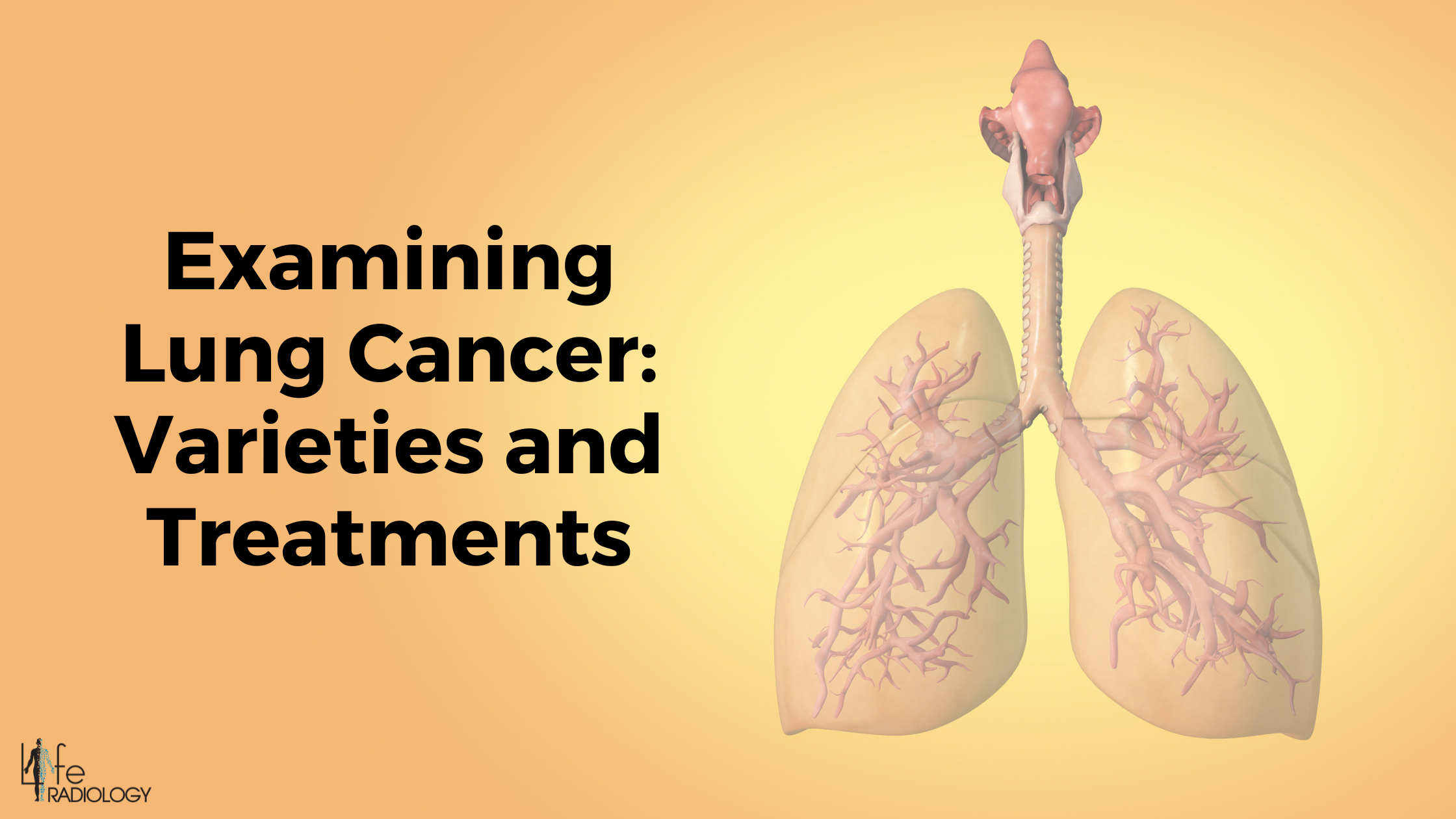Examining Lung Cancer: Varieties and Treatments
Lung cancer remains one of the most prevalent and challenging health concerns globally. The importance of comprehending its intricacies—from its various forms and signs to the most recent progress in therapy—cannot be emphasized enough.
Identifying and treating this disease at an early stage is crucial in boosting survival rates and bettering the life quality of those impacted by it.
Types of Lung Cancer:
1. Non-Small Cell Lung Cancer (NSCLC):
- Adenocarcinoma: This type often starts in the outer areas of the lungs and is the most common form of lung cancer among non-smokers.
- Squamous Cell Carcinoma: Typically found in the larger airways of the lungs, often linked to smoking.
- Large Cell Carcinoma: A less common type that can appear in any part of the lungs
2. Small Cell Lung Cancer (SCLC):
- Known for its rapid growth and tendency to spread quickly, it is often associated with heavy smokers.
Rare Types:
- Carcinoid Tumors: Slow-growing tumors originating in the lung's neuroendocrine cells.
- Sarcomatoid Carcinoma: An aggressive subtype showing characteristics of both carcinomas and sarcomas.
- Pulmonary Blastoma: Extremely rare and fast-growing, usually found in young adults.
Symptoms of Lung Cancer
Recognizing the early signs and symptoms of lung cancer is crucial for timely intervention and improved outcomes. Common symptoms often include:
- A persistent cough that worsens over time.
- Discomfort or pain in the chest.
- Shortness of breath or wheezing.
- Unexplained weight loss.
- Hoarseness.
- Coughing up blood or rust-colored sputum.
- Fatigue and recurrent infections.
It's important to note that symptoms may vary based on the type and stage of lung cancer. Early-stage lung cancer might not present noticeable symptoms, making routine screenings imperative, especially for individuals at higher risk, such as smokers and those with a family history of the disease.
Different Types of Lung Cancer Treatments:
Lung cancer treatment plans are tailored to the type and stage of the disease, as well as the individual's overall health. Several treatment modalities are commonly used:
- Surgery: Surgical procedures aim to remove the cancerous tissue from the lung. This may involve removing a portion of the lung (lobectomy) or the entire lung (pneumonectomy).
- Chemotherapy: Powerful drugs are administered either orally or intravenously to destroy cancer cells or stop their growth. It can be used alone or in combination with other treatments.
- Radiation Therapy: High-energy beams, such as X-rays, are directed at the cancerous area to kill cancer cells or prevent their growth. This treatment can be external (external beam radiation) or internal (brachytherapy).
- Targeted Therapy: These drugs target specific abnormalities in cancer cells, blocking their growth and spread. They are particularly effective against certain types of non-small cell lung cancers.
- Immunotherapy: This treatment boosts the body's immune system to help fight cancer cells more effectively. It works by targeting specific proteins in cancer cells or immune cells, enabling the immune system to recognize and destroy cancer cells.
Advancements in Lung Cancer Treatment:
In January, the FDA approved Keytruda (pembrolizumab) for stages 1B, 2, or 3A non-small cell lung cancer (NSCLC) post-surgery and platinum-based chemotherapy. This approval marks a significant step in preventing cancer recurrence.
Dr. Roy S. Herbst, a leading expert in lung cancer and professor of medicine at Yale Cancer Center, highlighted Keytruda's importance. He described it as a crucial adjuvant therapy, offering an extra layer of protection against cancer resurgence and spreading.
Keytruda, an immune checkpoint inhibitor, activates the body's immune system, enhancing its ability to identify and combat cancer cells effectively.
This milestone in lung cancer treatment aligns with previous advancements:
- Immunotherapy: Drugs like pembrolizumab, nivolumab, and atezolizumab showed efficacy, particularly in advanced lung cancer cases where standard treatments were ineffective.
- Targeted Therapy: Precision medicine focused on genetic mutations like EGFR or ALK rearrangements. Medications such as osimertinib and crizotinib demonstrated promise in managing specific subsets of lung cancer.
- Liquid Biopsies: Non-invasive tests analyzing circulating tumor DNA emerged as an alternative for monitoring treatment response and early detection of cancer recurrence.
- Advancements in Radiation Therapy: Techniques like SBRT and proton therapy aimed to deliver precise radiation doses, potentially improving outcomes while reducing side effects.
- Combination Therapies: Researchers explored synergistic effects of chemotherapy, immunotherapy, and targeted therapy to combat resistance mechanisms in lung cancer cells.
- Clinical Trials and Personalized Medicine: Ongoing trials aimed to personalize treatment based on individual tumor characteristics, exploring innovative therapies and drug combinations.
Keytruda's approval marks a significant advancement in lung cancer care, enriching treatment options and inspiring hope for enhanced patient outcomes and a better quality of life.
Diagnosis of Lung Cancer: Utilizing X-Rays and Medical Scanning
Diagnostic imaging plays a pivotal role in identifying lung cancer and determining its extent. Common methods include:
- X-rays: A basic imaging test that uses low doses of radiation to create images of the lungs, helping identify abnormal masses or nodules.
- CT Scans (Computed Tomography): These more detailed scans provide cross-sectional images of the chest, allowing for precise detection and characterization of lung abnormalities.
- PET Scans (Positron Emission Tomography): These scans involve injecting a small amount of radioactive material that highlights areas of increased metabolic activity, aiding in identifying cancerous areas.
- MRI (Magnetic Resonance Imaging): Although less commonly used for lung cancer diagnosis, MRIs can provide detailed images, especially for evaluating the chest wall or areas close to the lungs.
These diagnostic tools enable healthcare professionals to detect lung cancer in its early stages, accurately stage the disease, and guide treatment decisions.
Conclusion:
From the more prevalent non-small cell lung cancer (NSCLC) to the aggressive small cell lung cancer (SCLC) and the rare subtypes, each variant demands unique approaches to diagnosis and treatment.
The journey to combat lung cancer involves a multi-faceted approach, encompassing early detection, advancements in treatment modalities, and ongoing research into innovative therapies. As we witness groundbreaking developments, such as the recent approval of Keytruda and advancements in precision medicine and targeted therapies, the prospects for improved outcomes and enhanced patient care continue to evolve.
Nevertheless, the battle against lung cancer extends beyond medical advancements. Empowering individuals with knowledge about risk factors, symptoms, and the importance of regular screenings remains crucial. Smoking cessation and reducing exposure to environmental carcinogens are pivotal steps in preventing this disease.






